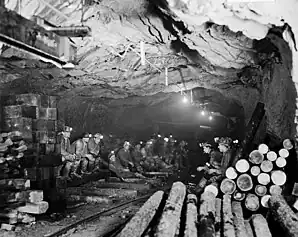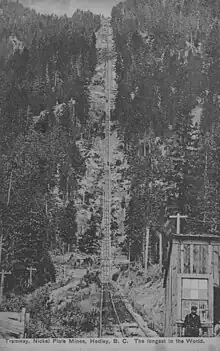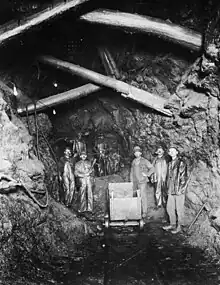Vancouver Island Coal Miners' Strike
The Vancouver Island Coal Miners' Strike was from 1912-1914. The coal miners in the Vancouver Islands refused to go to work, in protest of unsafe working conditions and unfair treatment. They began as peaceful protests, until built up anger caused by strike-breakers, also known as scabs, ruined the effectiveness of the strike and incited aggressive behavior. The militia was forced to step in and shut down the strike.[1]
Leading causes

The miners were unhappy with how much they were getting paid. Men recruited each other to work in order to support their families. Men, grandfathers, and even boys worked for little pay and in an unsafe environment. The pay was so small that families would even send their boys who were under the age of sixteen to work in the mines. They would hide their age from local officials, because the need for money was so great.[2] The mines were designed to mine mass amounts, prioritizing quantity of production rather than mining in a safe and effective manner. Their wages were inconsistent and subject to change every year. There was not a baseline pay, and miners' salaries could change based off of coal demand and other factors, manifesting a sense of agitation from the lack of reliability.[2] The introduction of Oriental Colliers in the 1870s worsened the issue of pay. They were willing to work for much less than the whites worked for, but this slowed the industries technological advances because the companies had access to cheap labor.[3]
In addition to the low pay, miners held resentment from previous gas explosions. Within the last 30 years leading up to the strike, 373 men died. Replacement workers were supposed to come and help ease the workload, but they never came.[4]
The unsafe working conditions were ignored. One worker, Mottishaw, who was a leader in the United Mine Workers of America (UMWA), reported unsafe working conditions at the Canadian Collieries, in Cumberland. He was then fired. Upset by this, the miners decided to take a two-day holiday to discuss what actions to take next.[5] When they returned to work after two-days off, they found that they had been locked out. The miners were now out of work.[6] 3700 miners were fired.[7] They repeatedly requested to civilly meet with Dunsmuir family, but were denied.[8] The strikers decided to go on a holiday until Mottishaw was re-hired. This holiday turned into a strike that lasted almost two years, and expanded to all the mines from Ladysmith to Cumberland.[6]

Mining companies involved
The mining companies that were involved, and most prominent in the Vancouver Islands at the time, were: The Canadian Collieries (Dunsmuir) Limited, the Western Fuel of San Francisco, the Pacific Coast Collieries, and the Nanaimo Coal Company.[1] The Canadian Collieries were based in Cumberland and Extension.[1] Owned by the Dunsmuir family, the company played a significant role in the strike by firing a union leader with the last name "Mottishaw".[5] This was one of the strike's leading causes. The Western Fuel of San Francisco was based in Nanaimo and owned many of the mines there.[1] The Pacific Coast Collieries only had minor involvement, and were located in South Wellington. The Nanaimo Coal Company stands apart from the other three, as it was the sole company to "sign an agreement with the union."[1]
These mining companies (excluding the Nanaimo Coal Company) were opposed to the unions, because they were a threat to the coal companies' power and authority. They coal companies were also dealing with the competition of fuel oil. Because of the potential replacement of coal as fuel with oil as fuel, they worked the miners extra hard and with less pay. This was in an effort to keep up with fuel oil and to stay in business. They needed to pay workers less in order to make a profit. However, unions demanded more pay, causing an issue for the coal companies. They did not want to increase the miners' pay, at the risk of losing their business, and of the entire coal mining industry being replaced by an alternate fuel source.[1] They also had the support of the government, because the economy was so dependent upon the coal industry.[6]
The strike

The strike began peacefully, and occurred from Ladysmith to Cumberland.[7] Many strikebreakers would hang out in Ladysmith during the daytime, and did not cause much commotion. The unions would provide the families with salaries, and women would work. The mines in Cumberland found ways around the strike, through the means of targeting Asian workers. The mines threatened to have the Asian workers deported if they did not break the strike. This forced them to continue working for the mines, and also angered the strikers. Eventually, as strikebreakers continued going to work, the strike became un-effective.[1] After two years of striking, the strikebreakers became a source of frustration to the strikers, and strikers began to threaten or hurt scabs on their way to work.[5]
Eventually, the striker's frustrations surpassed their desire to keep their protests peaceful, and the protests turned violent. Even people who were uninvolved in the strike wanted to join the excitement, which led to a dangerous riot in Ladysmith where many were injured and some died.[5] Afterwards, the strikers resumed peaceful protesting. However the government still called in the militia to end the strike. Unions ran out of money to pay salaries, and soldiers were drafted to a new war in Europe;[1] the 23-month strike died in 1914.[7]
References
- Bowen, Lynne. "The Great Vancouver Island Coal Miners' Strike 1912-1914". Journal of the West 23 (4): 33.
- Belshaw, John Douglas. "The Standard of Living of British Miners on Vancouver Island, 1848-1900 No. 84: Winter 1989-90". BC Studies.
- Gallacher, Daniel Thomas. "Men, Money, Machines : Studies Comparing Colliery Operations and Factors of Production in British Columbia's Coal Industry to 1891". The University of British Columbia. Ph.D. Diss. University of British Columbia.
- Schade, Daniel. "A Militia History of the Occupation of the Vancouver Island Coalfields, August 1913". BC Studies, No.182 (Summer 2014).
- Dag, Pluton. "4. The Great Vancouver Island Coal Strike -- KnowBC - the leading source of BC information". www.knowbc.com.
- Hinde, John Roderick (2003). When Coal Was King: Ladysmith and the Coal-Mining Industry on Vancouver Island. Vancouver: UBC Press. ISBN 9780774840149.
- "The Great Coal Strike 1912-1914". Working People Built BC. Retrieved March 2, 2021.
- Seager, Allen; Perry, Adele (1997). "Mining the Connections: Class, Ethnicity, and Gender in Nanaimo, British Columbia, 1891". 30.
{{cite journal}}: Cite journal requires|journal=(help)
Further reading
- Orr, Allan Donald. 1968. “Western Federation of Miners and the Royal Commission on Industrial Disputes in 1903 with Special Reference to the Vancouver Island Coal Miners’ Strike.” MA.Thesis. University of British Columbia. 1958. doi:http://dx.doi.org/10.14288/1.0104477.
- Seager, Allen. 1985. Socialists and Workers: The Western Canadian Coal Miners, 1900-21. Labour / Le Travail, 23-NaN. https://www.erudit.org/en/journals/llt/1985-v16-llt_16/llt16art01.pdf